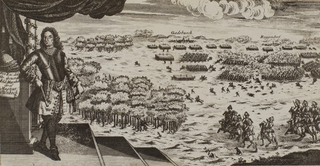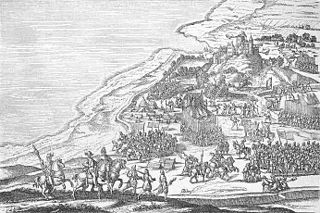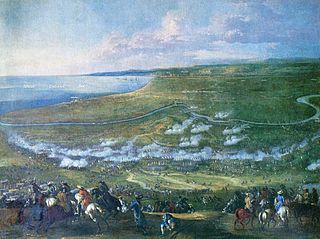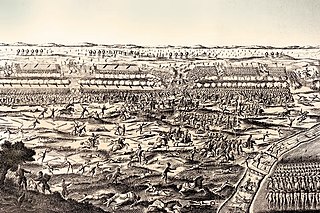
Halland is one of the traditional provinces of Sweden (landskap), on the western coast of Götaland, southern Sweden. It borders Västergötland, Småland, Scania and the sea of Kattegat. Until 1645 and the Second Treaty of Brömsebro, it was part of the Kingdom of Denmark. Its name means Land of Rocky Slabs referring to the coastal cliffs of especially the northern part of the region.

The Battle of Gadebusch or Wakenstädt was Sweden's final great victory in the Great Northern War. It was fought by the Swedes to prevent the loss of the city of Stralsund to Danish and Saxon forces.

The Northern Seven Years' War was fought between the Kingdom of Sweden and a coalition of Denmark–Norway, Lübeck, and Poland–Lithuania between 1563 and 1570. The war was motivated by the dissatisfaction of King Frederick II of Denmark with the dissolution of the Kalmar Union, and the will of King Eric XIV of Sweden to break Denmark's dominating position. The fighting continued until both armies had been exhausted, and many men died. The resulting Treaty of Stettin was a stalemate, with neither party gaining any new territory.

The Scanian War was a part of the Northern Wars involving the union of Denmark–Norway, Brandenburg and Sweden. It was fought from 1675 to 1679 mainly on Scanian soil, in the former Danish–Norwegian provinces along the border with Sweden, and in Northern Germany. While the latter battles are regarded as a theater of the Scanian war in English, Danish, Norwegian and Swedish historiography, they are seen as a separate war in German historiography, called the Swedish-Brandenburgian War.

The Battle of Halmstad, also known as the Battle at Fyllebro, was fought on August 17, 1676, at Fyllebro, approximately 4 km (2.5 mi) southeast of the town of Halmstad in the province of Halland in southwest Sweden. It was the last battle in Halland between Denmark and Sweden.

Daniel Rantzau was a Danish-German general. He was known for his leadership during the Northern Seven Years' War. For some years, he fought in Germany and Italy, and also took part in the Danish conquest of Dithmarschen in western Holstein during 1559. Rantzau also seems to have been a clear pro-war spokesman before the outbreak of the Northern Seven Years' War with Sweden in 1563.
The Military timeline of Denmark is centered around an involvement in wars in Northern Europe since 793 and, recently, elsewhere.
The Conquest of Jemtland refers to the Norwegian (re-)conquest of the province of Jämtland in the summer of 1677 during the Scanian War. The conquest was short-lived; Sweden was able to regain control of the province in November the same year.

The March Across the Belts was a military campaign waged by the Swedish Empire across the ice between the Danish islands. It lasted between 30 January and 15 February 1658, ending with a decisive victory for Swedish King Charles X Gustav during his first Danish war.

The Battle of Helsingborg was the last major engagement of the Great Northern War to take place on Swedish soil. It resulted in a decisive victory of a Swedish force of 14,000 men under the command of Magnus Stenbock against a Danish force of equal strength under the command of Jørgen Rantzau, ensuring that Denmark's final effort to regain the Scanian territories that it had lost to Sweden in 1658 failed. The battle was fought on March 10, 1710, in the province of Scania, just outside the city of Helsingborg, and directly on the Ringstorp heights just north-east of the city.
The military history of Norway commences before the Viking Age with the internal wars fought between regional kings to obtain the supreme kingship of the whole of Norway. The most famous period of Norwegian history and thus military history is the Viking Age, but the early Middle Ages was the era when Norwegian military power in Europe reached its peak. Since then the Norwegian military has experienced long periods of neglect, but also rearmament and victories.

The Battle of Warksow took place on the Baltic Sea island of Rügen on 8 January (O.S.)/18 January(N.S.)1678 during the Swedish-Brandenburg War. In the battle Swedish forces defeated an allied army composed mainly of Danes supported by a smaller contingent of Brandenburg and Hesse-Cassel troops.
The Battle of Brobacka was fought in Alingsås between Sweden and Denmark on 9 August 1566. The Swedish army under command of Charles de Mornay successfully managed to ambush Daniel Rantzau and his Danish army on their arrival back from their looting train in Västergötland, southwest of Sweden.
Events from the 1560s in Denmark.

Events from the year 1565 in Sweden
The Battle of Wismar took place on December 5, 1711 close to Wismar, Swedish Empire during the Great Northern War. A 3,000 strong Danish force under the command of Jørgen Rantzau blocked the Swedish city of Wismar. The Swedes under Martin von Schoultz, sent out 2,500 men from their garrison in an attempt to surprise the Danish forces camping a distance away. However, the Danish commander got words of the approaching Swedes and countered them, resulting in 478 Swedes dead, with another 1,500 captured to only 300 Danes killed and wounded.
Scanian Regiment, was a Danish national infantry regiment 1615–1658. It was raised among the peasantry in Skåneland to augment the mercenary army, and fought against Habsburg during the Thirty Years' War and against Sweden in 1657–1658. When Skåne was ceded to Sweden in 1658, it was disbanded.
After having been forced to sue for peace with Sweden in 1700, the Danish army was much larger than the kingdom could support. The king then decided to put almost half of the army under Allied command during the War of the Spanish Succession. Ten thousand soldiers served as an auxiliary corps to the Habsburg monarchy, fighting under Eugene of Savoy in northern Italy, including the battles of Cremona and Luzzara. Later they participated in the suppression of the Hungarian insurgency.
Having been forced to sue for peace with Sweden in 1700, the Danish army was much larger than the kingdom could support. The King decided to put almost half of the army under Allied command during the War of the Spanish Succession. Twelve thousand soldiers were in 1701 made available to the Allied powers in Flanders through a treaty with the Dutch Republic and England. The Danish corps fought under Marlborough at the battles of Blenheim, Ramillies, Oudenarde, and Malplaquet suffering heavy losses. It returned to Denmark in 1713 and 1714.

The Siege of Älvsborg, also known as the Siege of Elfsborg, was a siege of the Swedish fortress of Älfsborg by the Danish army under King Frederick II at the start of the Northern Seven Years' War. The siege ended in a quick Danish victory, and the Swedish commander would surrender the fort before any direct assault would be initiated.











